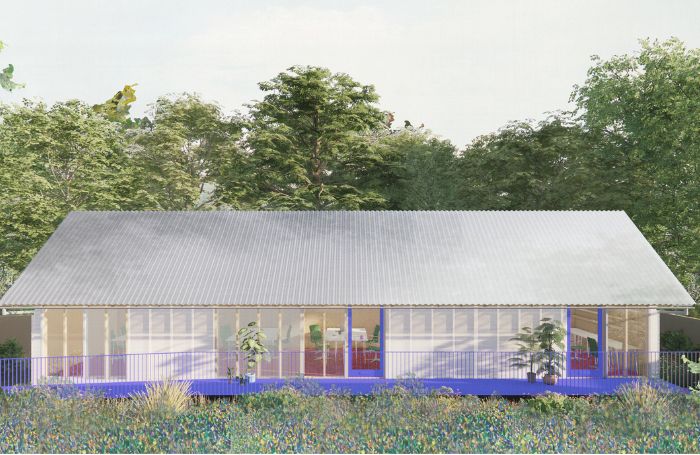It is well known that there is a surge of enthusiasm for undertaking projects that deliver social value among the emerging generation of young architects.
Many will say that the idea of helping their communities via architecture is what attracted them to the profession in the first place. However, the reality for most start-up practices means intense competition to secure private sector work and domestic projects.
The reality of running a business and all the responsibilities that it brings often pushes well-intentioned projects in the community down the list of priorities.
Sam Nelson, Director at TYPE and Part 1 tutor at the University of Cambridge says the ambition to deliver some form of public service is evident among students and peers.
However, opportunities to do so in a diminished public sector are few and far between. Local authorities, for instance, simply don’t always engage with architects on public projects like they used to.
One of the consequences is that charities and non-profit organisations fill the void in providing services and often rely on community-based projects. Sam’s practice is one of a growing number of small offices that are finding ways to help locally and run a thriving business.
It's important to recognise that community-based projects should never replace paid work nor should be the responsibility of architects. However, many practices choose to engage with positive works in their local community, which sit alongside their usual paid work.
“Our generation of architects wants to work on projects with a social purpose, and need to balance this with fee paying work but we also need to work in the private sector to survive,” Sam suggests. “Doing 'pro bono' work is a way of working on projects for the public good and for people who are in the most need.”

How do you balance community work with your business model?
Sam’s commitment to the social impact of architecture grew out of his early experience of working with charities and NGOs with a focus on shelter, including Engineers Without Borders and an internship at the Red Cross.
Now, with his studio TYPE - based in east London - Sam is finding ways to balance work in the community with traditional, paid projects.
The practice has just designed a new low-energy headquarters and base of operations for SUFRA NW, a charity tackling both the causes and consequences of poverty in northwest London.
TYPE has waived fees for Stages 0 to 3, and managed to obtain structural design and building control advice from some like-minded professionals.
The team has also engaged with a large contractor that takes on some community-based work, which will be key to meeting the major costs of labour and materials. An appointment with SUFRA NW was also drawn up, just like any other project.
TYPE says that it feels that it has some responsibility to the environment and the public, which underpin its core principles. So much so, that directors have decided that undertaking work of social value is a much better use of time and resources than many competitions.
Working on a live project like this, Sam argues, is often a better use of skills than entering the free-for-all of architectural competitions.
What has TYPE done in the community?
SUFRA will be TYPE’s first community-based project, but Sam expects it will allocate a budget for a similar project each year moving forward.
Based at St Raphael’s Estate in Brent, SUFRA provides a community hub with a food bank, community kitchen and a community Edible Garden. The new headquarters, which is currently in for planning, will be a low energy cabin built from readily available materials in standard sizes.
Timber stud cassettes are used for walls, roof and flooring, all filled with wood fibre insulation and clad with particle board and a transparent rain screen of polycarbonate sheeting. The building and site will be powered by solar panels.
Land has been donated by the council on a short lease, so the structure and its screw pile footings could be disassembled and relocated in the future if necessary.
Working within budgetary and time constraints is a real driver for innovation, says Sam. It also becomes clear that community-based projects projects are not undertakings that you can just work on and complete in your free time if you are a small practice.
It takes plenty of in-house planning, an allocation of time and resources, and the same approach and processes that would be applied to a paid project.
“There is a huge cost to the practice in time and resources, and there are the insurance implications and PI liabilities to consider,” Sam continues.
“You still have to try to deliver a best practice project while overcoming budgetary constraints and taking time to engage with your client. You have to deliver a building that is robust and sustainable in all the ways a fee-paying project would be.
Honestly, it is really difficult to balance the project financially in a small practice, but it is possible and we are managing to do it.”

What is to be gained from work in the community?
So why undertake a project of this nature?
The personal payback of contributing to a community or a charity endeavour should not be overlooked, Sam argues. He points out that there is a lot of evidence to show that volunteering and getting involved in community-based projects, or in a cause you believe in, can benefit your own wellbeing and mental health, as well as your social conscience.
Sam also suggests that staying local is the easiest way to get involved in community projects. There are networks that practices can plug into, such as All in Awe, a social enterprise that connects charities and non-profits with creative professionals.
The question then is why would a small practice get involved in these types of projects work now, when a lot of architects are struggling to find work and there is a cost of living crisis?
Sam’s answer is that it is times like these, when people are really struggling, that it becomes more important than ever.
Thanks to Sam Nelson, Director, TYPE.
Text by Neal Morris. This is a Professional Feature edited by the RIBA Practice team and was updated on 24 November 2023. Send us your feedback and ideas.
RIBA Core Curriculum topic: Business, clients and services.
As part of the flexible RIBA CPD programme, professional features count as microlearning. See further information on the updated RIBA CPD core curriculum and on fulfilling your CPD requirements as a RIBA Chartered Member.









